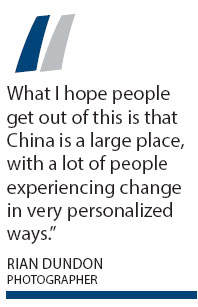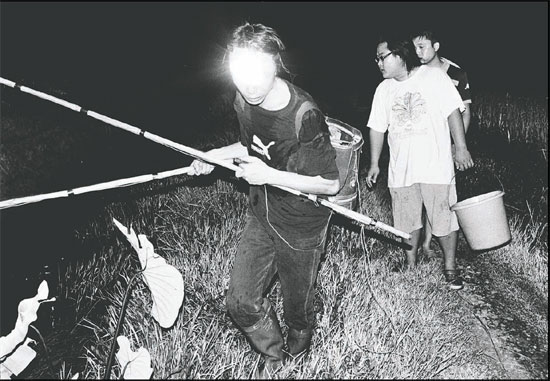Capturing a city's complex lives in stark images
Updated: 2013-01-11 12:22
By Kelly Chung Dawson in New York (China Daily)
|
||||||||
|
Rian Dundon arrived in Jishou in 2005, then moved on, with his camera, to other Chinese cities. Provided to China Daily |
Eleven of the world's 50 biggest cities are in China, but most Americans would be hard-pressed to name more than three.
Photographer Rian Dundon followed his girlfriend to China for a teaching position in 2005, landing first in Jishou, a mining city with a population under 300,000, and later Changsha, a provincial capital of more than 7 million people.
He spoke no Mandarin, and arrived with few preconceptions about what life in China might be like.
As a foreigner in a "second-tier" city (so named for its size and economic scale), Dundon found locals to be surprisingly friendly.
He frequented pool halls, skateboarded and made friends quickly, picking up a Hunan-accented Mandarin in the process. He began taking photos of what he would later dub "the other New China".
Those images are now available in the coffee-table book Changsha, published by Emphas.is, a crowd-funded platform for photojournalism.
The China presented in Dundon's pictures, made between 2005 and 2011, is neither the shiny metropolis nor the bucolic village ubiquitous in Western narratives.
"It is something else altogether - people in marginal but isolated places, aware of a world beyond their experience but reworking and inventing local versions of it according to their own imaginations and desires, constrained by material difficulties but in no way intimidated by their status as citizens of a purported backwater," writes Gail Hershatter, a professor of East Asian studies at the University of California, Santa Cruz, in the book's foreword.
"What we see of China here in the West is the east coast urban success story, or the rural left-behind poverty story," Dundon said. "I was very interested in photographing places and parts of China that weren't as exposed.
"What I hope people get out of this is that China is a large place, with a lot of people experiencing change in very personalized ways. I hope that this touches on a certain in-between or gray area of experience of life in provincial China."
The black-and-white film images, many developed in the darkened bathroom of Dundon's apartment in Changsha, Hunan province, feature his peers and friends. They are seen socializing at karaoke bars, working low-level jobs and in highly intimate shots of their home lives. Most of the people depicted are in their 20s or 30s.
"For me there's no distinction between work and my social life," Dundon said. "They are the same thing; that's how I work everywhere. I'm not really a photojournalist or a documentary photographer in the classical sense. What I do is more private or personal documentary-style photography. It's all connected for me."

Hershatter, author of The Gender of Memory: Rural Women and China's Collective Past (2011), advised Dundon on the project while the young man was enrolled in UC Santa Cruz's master of fine arts program in social documentation.
The professor was impressed by Dundon's photos, which depicted a culture that felt unfamiliar despite her extensive travels in China, Hershatter said.
She compared Dundon's work to the early writing of author Peter Hessler, whose book Rivertown details his time as a Peace Corps volunteer in Sichuan province in the 1990s.
"In a similar way, Rian's mode was to be moving through different situations but staying put long enough to actually get to know the people he was documenting," she said. "I think that because Rian is a skateboarder and hung out in local places like pool halls, his work gives you a sense of the kind of mobility experienced by people who are not well-educated. They aren't the winners in this reform, but they're not the losers, either. They're hustling as fast as they can, and Rian understands them as sympathetic, human characters, in part because some of them are his friends."
Most of the images are of Changsha, but Dundon followed his subjects to other cities and provinces, photographing them with their families, doing business or on the road.
The book features short essays, expanded from the journal Dundon kept during his time in China. In one piece, he writes about a restaurant owner who lost his business.
"Zhi Ge is slapping himself across the face, punching the side of his head with a closed fist," Dundon writes. "In the back of the van are the saddest of salvaged artifacts from the restaurant: notebooks and napkins, a few half-finished bottles of baijiu and Pepsi and a greasy glass table top for the new office he doesn't have a location for yet. Items rescued because Zhi is already onto the next game, already focused on the next opportunity for business.
"He is modern, he is malleable. If the restaurant didn't work out, and funeral consulting isn't proving lucrative enough, he can do something else. There is always something else."
Although his images are often dark and desolate, Dundon didn't intend for them to convey hopelessness.
"I hope that while there is darkness, there's some sense of hope and levity. I tried to balance that. I'm not a documentarian and I don't claim to represent these people; I only purport to represent myself and my own story. That edginess or grittiness, a lot of it can probably be traced to my own sense of dislocation and alien-ness at living in a place so foreign to me during that time."
The images can also be viewed as a reflection on the life of a city that in 1938 burned nearly to the ground in the War of Resistance Against Japanese Aggression, Hershatter said.
"Often, when people adapt a gritty style of photography, they're showing abject images of human suffering, and that isn't what Rian is doing," she said. "Changsha is an environment that lost 2,000 years of existence in a 20th-century fire, and now on top of that we see layers and layers of destruction and construction that are part of the reform.
"It's a grim, ripped-up landscape. Rian's photos don't beautify it, but they don't make it look miserable, either. For him, it's just the city in which these people live. One of the biggest messages you get from these images is that China isn't uniform."
Dundon's hope is that the book will suggest a more complicated narrative.
"We should be moving away from simplistic interpretations of China," he said. "Photography tells stories you can't put into words; it's particularly good for stories that are undefined. I want to complicate the conversation, because life is messy and complication is a good thing."
|
Dundon wants to show "the other new China" through his photos of people in Changsha, the capital of Hunan province. Provided to China Daily |

 In Photos: 7.0-magnitude quake hits Sichuan
In Photos: 7.0-magnitude quake hits Sichuan
 Li Na on Time cover, makes influential 100 list
Li Na on Time cover, makes influential 100 list
 FBI releases photos of 2 Boston bombings suspects
FBI releases photos of 2 Boston bombings suspects
 World's wackiest hairstyles
World's wackiest hairstyles
 Sandstorms strike Northwest China
Sandstorms strike Northwest China
 Never-seen photos of Madonna on display
Never-seen photos of Madonna on display
 H7N9 outbreak linked to waterfowl migration
H7N9 outbreak linked to waterfowl migration
 Dozens feared dead in Texas plant blast
Dozens feared dead in Texas plant blast
Most Viewed
Editor's Picks

|

|

|

|

|

|
Today's Top News
Live report: 7.0-magnitude quake hits Sichuan, heavy casualties feared
Boston suspect cornered on boat
Cross-talk artist helps to spread the word
'Green' awareness levels drop in Beijing
Palace Museum spruces up
First couple on Time's list of most influential
H7N9 flu transmission studied
Trading channels 'need to broaden'
US Weekly

|

|









